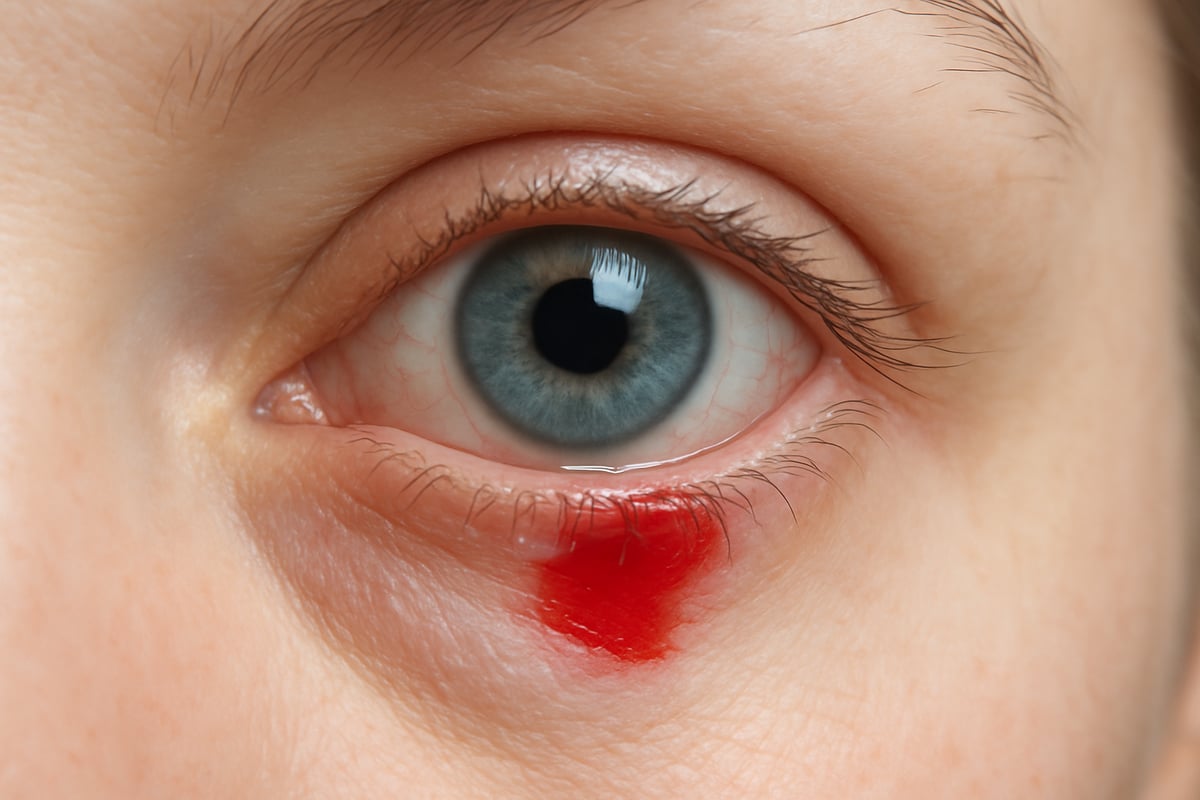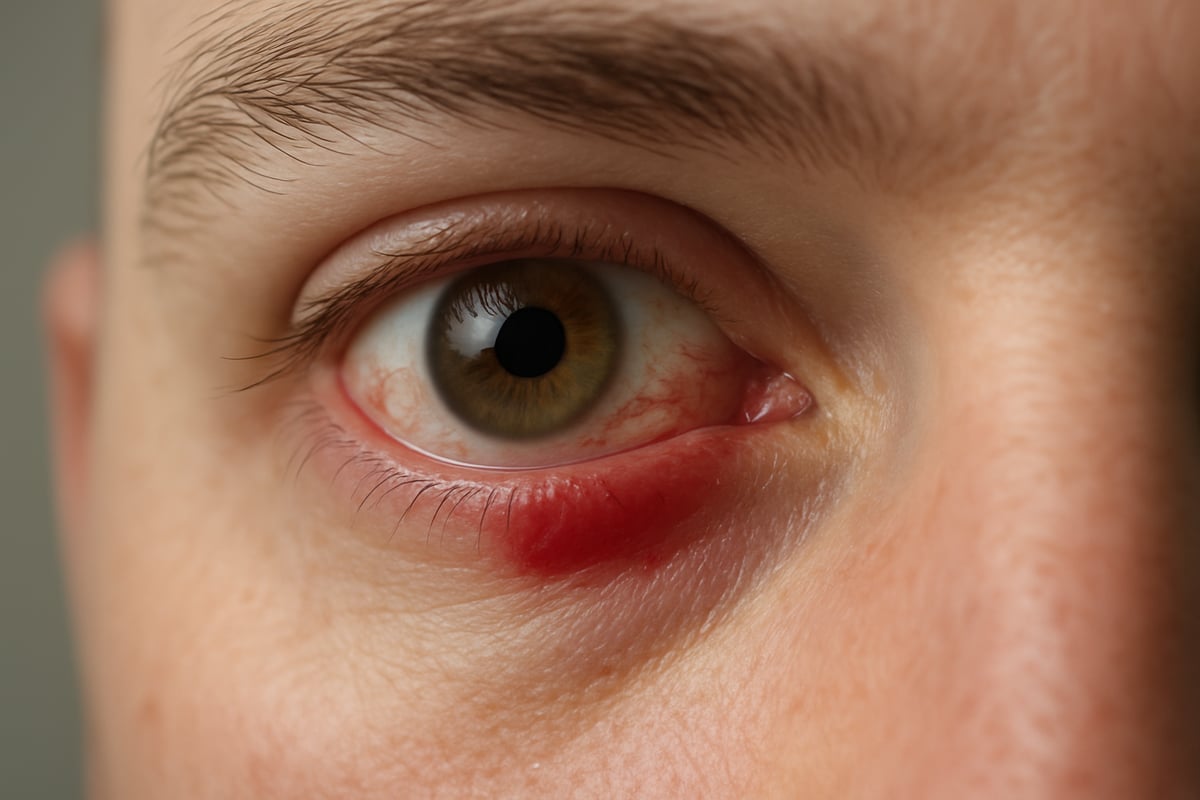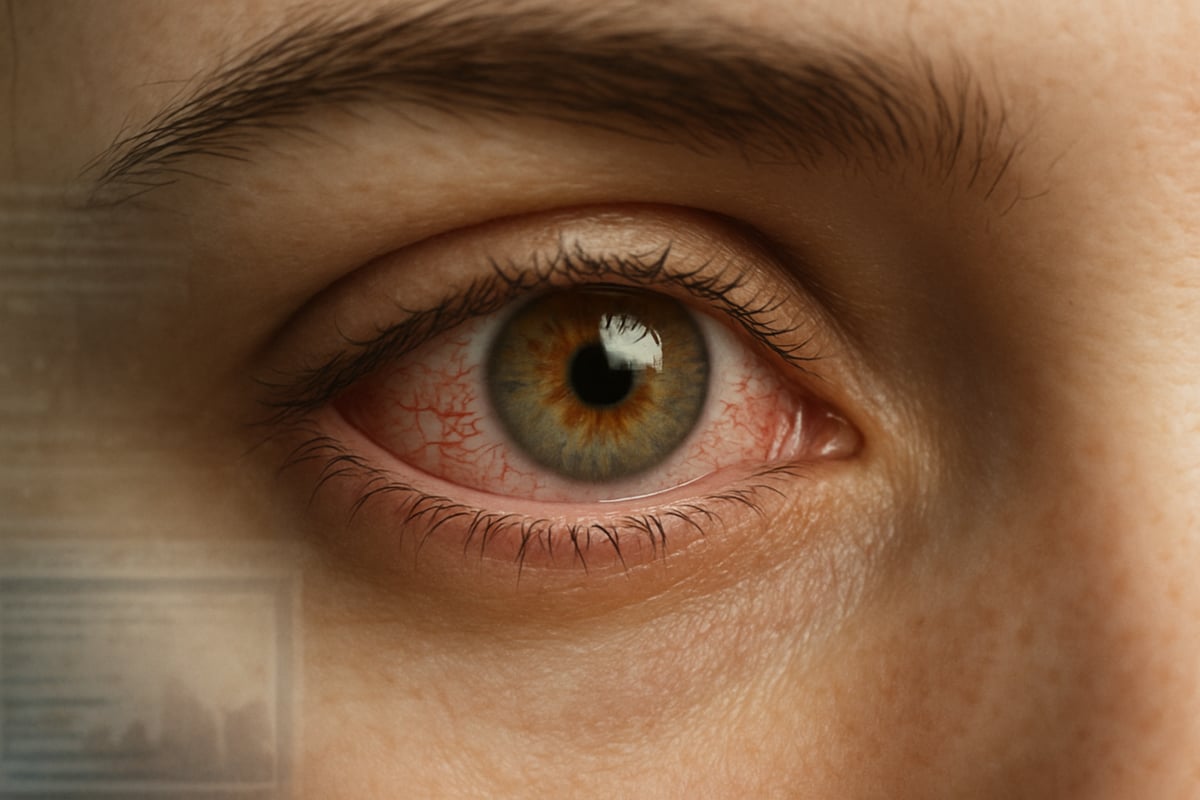Have you ever glanced in the mirror and spotted a sudden red patch in your eye? This common sight can lead to questions about your eye health, especially as we move into 2025.
Understanding blood vessels in eye causes is more important than ever. With new research and trends emerging, knowing what triggers these changes can help you protect your vision.
In this comprehensive guide, we will explore the latest findings on blood vessel anatomy, common and new causes, symptoms, risk factors, prevention, and treatments. Stay informed and discover practical steps for optimal eye health.
Understanding Blood Vessels in the Eye
Noticing changes in your vision or sudden redness can be alarming. To understand blood vessels in eye causes, it is important to first explore the anatomy and function of these vital structures.

Anatomy and Function of Eye Blood Vessels
The eye contains several key blood vessels, each serving a unique role. The conjunctival vessels are visible on the surface, while the retinal and choroidal vessels are located deeper, nourishing the retina and supporting vision. Arteries deliver oxygen-rich blood, veins carry waste away, and capillaries handle nutrient exchange.
Blood flow through these vessels is crucial for maintaining eye health. Over 90 percent of eye nutrients are delivered via the microvasculature. Healthy vessels keep vision clear by supplying oxygen and removing toxins. If vessel walls weaken, issues can develop that threaten eyesight.
Vessel integrity is influenced by many factors, including deficiencies in vitamins and minerals. For more on how deficiencies affect eye health, see Eye deficiencies and vascular health. Understanding blood vessels in eye causes helps you appreciate why vessel health matters for long-term vision.
Types of Blood Vessel Issues in the Eye
Various blood vessels in eye causes can lead to visible or hidden problems. The most common is subconjunctival hemorrhage, where a small vessel breaks and causes a bright red patch on the sclera. Deeper issues include retinal and choroidal hemorrhages, which may impact vision more severely.
Other conditions involve microaneurysms, vascular leakage, or inflammation such as vasculitis. Surface issues are usually harmless, but deeper vascular problems may signal underlying health concerns. Any disruption in blood flow or vessel structure can affect your sight, including vision loss from retinal hemorrhages.
By recognizing the different blood vessels in eye causes, you can better understand the importance of protecting your ocular health and seeking prompt evaluation when needed.
Common Causes of Broken Blood Vessels in the Eye
Noticing a red spot in your eye can be unsettling. Understanding blood vessels in eye causes is crucial for recognizing what triggers these incidents and how to reduce your risk. Let us explore the most common contributors to this phenomenon.

Everyday Triggers and Risk Factors
Many cases of broken blood vessels in the eye stem from daily activities or minor incidents. Sudden increases in pressure, such as coughing, sneezing, vomiting, or lifting heavy objects, can cause delicate vessels to rupture. Eye rubbing, accidental trauma, or improper contact lens use may also contribute.
Straining during bowel movements or intense physical exertion sometimes leads to vessel breaks. Medical procedures involving the eye and the use of blood-thinning medications, like aspirin or anticoagulants, further raise the risk. Underlying conditions such as hypertension or diabetes play a key role as well.
For more detailed information on risk factors and indicators, you can refer to Subconjunctival Hemorrhage: Risk Factors and Potential Indicators. Understanding these blood vessels in eye causes helps you identify and avoid common triggers.
Chronic Medical Conditions Linked to Eye Vessel Issues
Chronic diseases are major contributors to blood vessels in eye causes. Diabetes mellitus can damage the tiny vessels in the retina, leading to diabetic retinopathy. Hypertension and arteriosclerosis weaken arterial walls, making them prone to rupture.
Blood clotting disorders, such as hemophilia or thrombocytopenia, increase the likelihood of spontaneous bleeding. Autoimmune diseases may cause inflammation of the vessels, known as vasculitis, affecting eye health. Patients with uncontrolled diabetes often experience recurring hemorrhages, highlighting the need for careful management of these conditions.
Age, Genetics, and Lifestyle Factors
As we age, blood vessels naturally become more fragile, making blood vessels in eye causes more prevalent among older adults. Genetics also play a role, as some individuals inherit a predisposition to weak capillaries.
Lifestyle choices matter. Smoking and excessive alcohol consumption can impair vessel integrity, raising the risk of breaks. On the other hand, regular exercise supports cardiovascular health and may help protect eye vessels. A sedentary lifestyle, in contrast, is linked to poorer vascular resilience.
By understanding these blood vessels in eye causes, you can make informed decisions to protect your vision and overall eye health.
Recognizing Symptoms and When to Worry
Noticing changes in your eye can be unsettling, especially if you spot a vivid red patch. Understanding blood vessels in eye causes is essential for knowing when to monitor symptoms and when to take action. This section will help you recognize typical signs, distinguish between common conditions, and determine when medical evaluation is necessary.

Signs of Broken Blood Vessels
A sudden, bright red patch on the white part of your eye is the most recognizable sign of a broken blood vessel. Most people notice this change in the mirror or when someone else points it out. These patches are usually not accompanied by pain, discharge, or vision changes.
You might feel a mild itchiness or a scratchy sensation, but significant discomfort is rare. Typically, the redness from blood vessels in eye causes will not spread or worsen, and the affected area does not swell. Most subconjunctival hemorrhages heal on their own within one to two weeks, without the need for treatment.
Common symptoms to watch for:
- Sudden red spot on the sclera
- Mild irritation or scratchiness
- No change in vision or significant pain
If you have experienced blood vessels in eye causes before, you may recognize the benign nature of these symptoms. However, always pay attention to any new or unusual developments.
Distinguishing from Other Eye Conditions
It is important to differentiate blood vessels in eye causes from conditions like conjunctivitis or allergies. Conjunctivitis, or pink eye, often includes symptoms such as discharge, itchiness, and a more diffuse redness. Allergic reactions may also cause itchiness, but are usually accompanied by watery eyes and a history of triggers like pollen.
More serious conditions such as iritis or keratitis can present with pain, light sensitivity, or blurred vision. Unlike a simple subconjunctival hemorrhage, these issues often involve deeper structures of the eye and may threaten your vision if left untreated.
Below is a quick comparison:
| Condition | Redness Pattern | Discharge | Pain/Discomfort | Vision Change |
|---|---|---|---|---|
| Subconjunctival Hemorrhage | Localized patch | None | Rare | No |
| Conjunctivitis | Diffuse redness | Yes | Mild | Rare |
| Allergies | Diffuse redness | Watery | Itchy | No |
| Iritis/Keratitis | Around iris/cornea | Possible | Moderate-High | Possible |
Understanding these differences can help you identify blood vessels in eye causes and know when further evaluation might be needed.
When to Seek Medical Attention
Most cases of broken blood vessels are harmless, but certain warning signs require prompt attention. Seek medical help if you notice:
- Persistent or recurring blood vessel breaks
- Pain, sensitivity to light, or blurred vision
- Redness that does not resolve after three to four weeks
While less than 5% of cases indicate a deeper problem, ongoing or unusual symptoms may signal underlying health issues. If you have chronic conditions such as hypertension or diabetes, or if you are taking blood-thinning medications, be extra vigilant.
Understanding the blood vessels in eye causes can empower you to make informed decisions. For more information on how underlying conditions can affect your vision and eye health, visit the Causes of vision deterioration page for further details.
Always consult an eye care professional if you are unsure or if your symptoms worsen. Early evaluation ensures the best possible outcome for your eye health.
Emerging Causes and Trends in 2025
The landscape of blood vessels in eye causes is shifting as we move through 2025. Recent changes in work habits, technology, and environmental exposures are influencing eye health in ways not seen before. Understanding these evolving factors can help you stay proactive about your vision.

Impact of Modern Lifestyles and Environmental Factors
In 2025, modern lifestyles are playing a significant role in blood vessels in eye causes. Increased screen time, especially among remote workers, is linked to digital eye strain and more frequent reports of visible vessel breaks. Urban pollution is another emerging concern, with particulate matter and irritants contributing to blood vessel fragility.
Contact lens use remains popular, but improper hygiene or overuse is leading to a rise in surface vessel issues. Research shows that digital fatigue is now a notable risk factor, as more people spend extended hours on devices. These trends highlight the importance of adjusting routines to protect eye health.
Advances in Medical Understanding
Medical research is uncovering new dimensions of blood vessels in eye causes. There is growing evidence that systemic inflammation, often driven by modern diets or stress, can weaken ocular vessels. Micronutrient deficiencies, especially low levels of vitamin C and antioxidants, are also associated with increased vessel breakage.
Recent studies have found that populations with poor nutrition are more susceptible to these issues. Health experts now recommend diets rich in fruits, vegetables, and omega-3 fatty acids to support vessel resilience. These findings emphasize the connection between whole-body health and eye wellness.
Genetic and Technological Insights
Genetic research is identifying markers that may predispose individuals to fragile blood vessels in eye causes. With advances in imaging, such as OCT angiography and AI-driven diagnostics, early detection of vessel problems is becoming more precise. Innovative technologies allow for better monitoring and risk prediction.
According to Advances in Ocular Aging: Combining Deep Learning, Imaging, and Liquid Biopsy Biomarkers, deep learning tools are now used to analyze eye microvasculature, offering new hope for early intervention. These breakthroughs are shaping the future of eye care and helping clinicians tailor prevention strategies for those at higher risk.
Prevention and Eye Health Strategies
Proactive prevention is essential for maintaining healthy eyes and reducing the risk of blood vessels in eye causes. By adopting evidence-based strategies, you can strengthen your ocular blood vessels and support lifelong vision. Small changes in daily habits and regular monitoring can make a significant difference.
Lifestyle Adjustments for Stronger Blood Vessels
Your daily choices play a critical role in preventing blood vessels in eye causes. Prioritize cardiovascular health through regular exercise, such as brisk walking or cycling. A balanced diet rich in antioxidants, vitamin C, and omega-3s helps reinforce vessel walls and reduce inflammation.
- Stay hydrated to maintain optimal blood flow within the eyes.
- Avoid smoking and limit alcohol intake to protect vessel integrity.
- Manage stress and maintain a healthy weight for additional vascular benefits.
For more in-depth guidance on preventative habits, explore this Care for eye health resource. These lifestyle shifts can help minimize the risk of common and emerging blood vessels in eye causes.
Eye Care Best Practices
Consistent eye care is another cornerstone in reducing blood vessels in eye causes. Always practice safe contact lens hygiene by cleaning lenses properly and replacing them as directed. Use protective eyewear during sports or hazardous activities to prevent trauma.
- Limit eye rubbing and address allergies promptly.
- Take frequent breaks from screens to ease digital eye strain.
- Use artificial tears if your eyes feel dry or irritated.
These best practices support overall eye health and help prevent issues associated with blood vessels in eye causes.
Monitoring and Regular Eye Exams
Routine monitoring is vital for early detection and prevention of blood vessels in eye causes. Schedule annual comprehensive eye exams, even if you have no symptoms. Eye care professionals can spot early signs of systemic conditions like diabetes or hypertension, which are linked to vascular problems.
| Exam Frequency | Recommended For | Key Benefit |
|---|---|---|
| Yearly | Adults | Early detection of issues |
| Biannually | High-risk | Monitor chronic conditions |
Track any changes in eye appearance or vision, and report concerns promptly. Staying vigilant ensures you address blood vessels in eye causes before they impact your quality of life.
Treatment Options for Broken Blood Vessels in the Eye
Noticing a red patch in your eye can be alarming, but most cases resolve without intervention. Understanding treatment options is crucial for managing symptoms and preventing recurrence. Let us explore how to approach broken blood vessels in the eye causes with confidence.
Home Remedies and Supportive Care
For most people, broken blood vessels in the eye causes minimal discomfort and resolve on their own within one to two weeks. Simple home remedies can ease irritation and support healing.
- Use artificial tears to reduce scratchiness.
- Apply a cold compress for brief periods to minimize redness.
- Avoid rubbing or touching the eye, which can worsen symptoms.
There is no need for topical antibiotics or eye drops unless advised by a doctor. Reassurance is key, as the red patch often fades naturally. If you experience recurrent issues, consider tracking potential triggers like heavy lifting or sneezing.
Medical Treatments and When They're Needed
Medical attention may be necessary if blood vessels in eye causes persistent or severe symptoms. Underlying systemic conditions such as diabetes or hypertension often require coordinated care. Physicians might adjust blood-thinning medications or suggest additional diagnostic tests.
In rare cases, laser treatment may be used for recurrent or complicated vessel breaks. For a comprehensive overview, review Effective eye treatment options to understand how professionals tailor interventions for various eye conditions.
If you notice pain, vision changes, or delayed healing, seek medical evaluation promptly. Early intervention can address underlying problems and prevent complications.
Prevention of Recurrence
Preventing future episodes begins with managing chronic health conditions and understanding blood vessels in eye causes. Regular exercise, a balanced diet rich in antioxidants, and avoiding smoking are essential steps.
- Schedule annual eye exams to catch systemic issues early.
- Practice safe contact lens hygiene.
- Limit activities that strain the eyes or increase pressure.
Patient education on risk factors and self-care can make a significant difference. Follow-up visits with eye care professionals ensure ongoing eye health and help identify any emerging concerns.
Differentiating Blood Vessel Issues from Other Eye Conditions
Not every red or irritated eye is caused by blood vessel problems. Many eye conditions can mimic the appearance of broken vessels, making it important to understand the differences. Knowing the range of possible blood vessels in eye causes will help you recognize when a seemingly minor issue might actually signal something more serious.
Common Eye Conditions That Mimic Vessel Problems
Several eye conditions can present with redness similar to blood vessel breaks. These include:
- Conjunctivitis (pink eye): Often comes with discharge and irritation.
- Allergic conjunctivitis: Triggered by allergens, usually with itching and watery eyes.
- Iritis and keratitis: Associated with pain, light sensitivity, and sometimes blurred vision.
- Ocular trauma: Direct injury can cause both vessel breaks and inflammation.
- Infections: Bacterial or viral infections may cause redness, swelling, and discharge.
Understanding these conditions is crucial for identifying blood vessels in eye causes, especially when multiple symptoms overlap.
Key Diagnostic Clues
When evaluating eye redness, pay attention to several diagnostic clues:
- Pattern and location of redness: Blood vessel breaks usually create well-defined red patches, while infections or allergies tend to cause diffuse redness.
- Associated symptoms: Look for pain, vision changes, or discharge, which may suggest a condition other than a simple vessel issue.
- Clinical examination: A thorough history and slit-lamp exam are essential for accurate diagnosis.
Emerging tools like EyeAI: AI-Assisted Ocular Disease Detection for Equitable Healthcare Access are helping eye care professionals distinguish between blood vessels in eye causes and other ocular diseases with greater precision.
When Specialist Evaluation is Crucial
Prompt referral to an eye specialist is vital when:
- Redness persists or recurs without clear cause.
- There are vision changes, pain, or light sensitivity.
- The problem does not resolve after 2–3 weeks.
- The presentation is atypical or severe.
Early specialist involvement can prevent complications and improve outcomes, especially when blood vessels in eye causes are uncertain or potentially vision-threatening.
Understanding the causes of blood vessel issues in your eye is the first step toward protecting your vision, especially if you’re facing conditions like macular degeneration or glaucoma. As we look ahead to 2025, staying informed about the latest research and treatment options can make a real difference. If you’re concerned about changes in your eye health or want to learn how MicroAcupuncture could help restore blood flow and support your retinal cells, we’re here to guide you every step of the way. Take the next step toward clearer vision—Schedule A Free Phone Call with us today.
